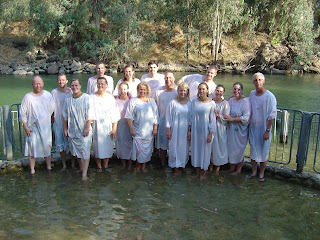I only have pictures from Week 1, but I thought I might as well post some. So, here you see us at the archeaological excavation just north of the Sea of Galilee. First our whole group and then some of the girls on my team. We had to get up super early in order to not have to work in the heat of the day, but we had gorgeous sunrises.
The only not-so-fun part was having to shovel out the sand from underneath the sifters every 30 minutes or so. That was back-breaking, but we tried to make it fun.
Since they opened up a new locus (square for digging) for our group, we spent the first two days moving rocks and digging through top-layer stuff. Finally we got down to some 1st century Roman finds. Even so, we did better with more "recent" discoveries. Some of our cool finds (besides gobs and gobs of everyday pottery) included a piece of an oil lamp rim (actually old), a 1962 Syrian coin (hey, I found that one, so let me enjoy my glory), and an 18th cenutry Austrian coin (can you imagine how excited I was to get to help read it with the archeaologist!!!):



Finding coins was always highlight! At the end of every day, all the finds - pottery, flint, fishing weights, grinding stones, coins, Roman glass, animal bones, and anything else special - was washed and taken back to camp where we had "pottery reading" every afternoon. This was when the archaeologist, Rami Arav, went through each locus' find and took out the things he wanted to keep, dated them, and explained the significance for us. Here you see me sorting and counting a locus' find (sometimes over 1,000 pieces of pottery!), Rami explaning some pieces to us, and the photographer taking pictures of the ones worth keeping:


Well, that's most of the stuff from the excavation. More of Israel to come.






 Masada is located in the Dead Sea Valley which is where these next three pictures were taken. That was a beautiful day! The view was tremendous (as you can see) even though it was about 108 degrees! We stopped at Qumran, which is the second picture, and could see from afar one of the caves in which most of the Dead Sea Scrolls were found. They weren't going to take us swimming, but we begged and begged to float around for a little bit, and they finally let us. It was such a unique experience because it really is hard to stand; you have to float. And if you flip over onto your stomach, it's nearly impossible to flip back. I think in this picture we have rocks on our bellies, and we're still not sinking.
Masada is located in the Dead Sea Valley which is where these next three pictures were taken. That was a beautiful day! The view was tremendous (as you can see) even though it was about 108 degrees! We stopped at Qumran, which is the second picture, and could see from afar one of the caves in which most of the Dead Sea Scrolls were found. They weren't going to take us swimming, but we begged and begged to float around for a little bit, and they finally let us. It was such a unique experience because it really is hard to stand; you have to float. And if you flip over onto your stomach, it's nearly impossible to flip back. I think in this picture we have rocks on our bellies, and we're still not sinking. 























